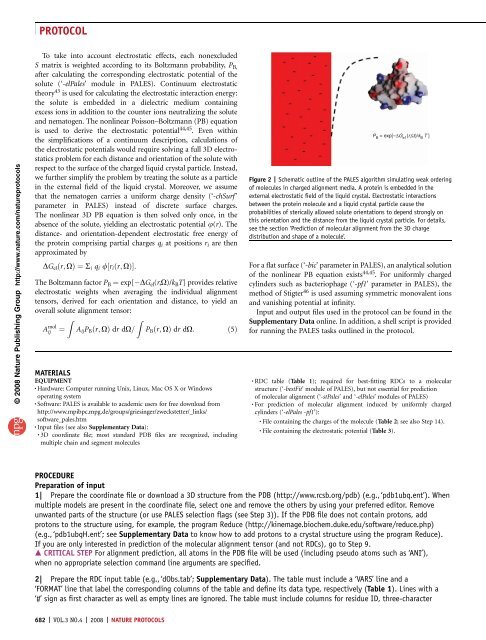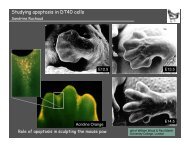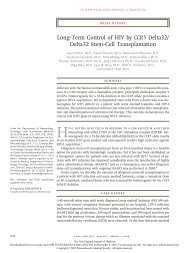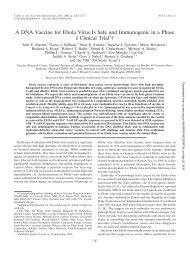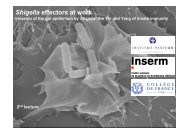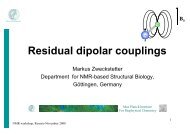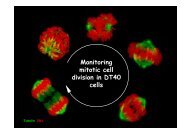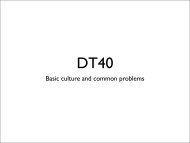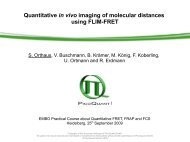b) NMR: prediction of molecular alignment from structure
b) NMR: prediction of molecular alignment from structure
b) NMR: prediction of molecular alignment from structure
Create successful ePaper yourself
Turn your PDF publications into a flip-book with our unique Google optimized e-Paper software.
© 2008<br />
Nature<br />
Publishing<br />
Group<br />
http:<br />
/ / www.<br />
nature.<br />
com/<br />
natureprotocols<br />
PROTOCOL<br />
To take into account electrostatic effects, each nonexcluded<br />
S matrix is weighted according to its Boltzmann probability, PB,<br />
after calculating the corresponding electrostatic potential <strong>of</strong> the<br />
solute (‘-elPales’ module in PALES). Continuum electrostatic<br />
theory43 is used for calculating the electrostatic interaction energy:<br />
the solute is embedded in a dielectric medium containing<br />
excess ions in addition to the counter ions neutralizing the solute<br />
and nematogen. The nonlinear Poisson–Boltzmann (PB) equation<br />
is used to derive the electrostatic potential44,45 . Even within<br />
the simplifications <strong>of</strong> a continuum description, calculations <strong>of</strong><br />
the electrostatic potentials would require solving a full 3D electrostatics<br />
problem for each distance and orientation <strong>of</strong> the solute with<br />
respect to the surface <strong>of</strong> the charged liquid crystal particle. Instead,<br />
we further simplify the problem by treating the solute as a particle<br />
in the external field <strong>of</strong> the liquid crystal. Moreover, we assume<br />
that the nematogen carries a uniform charge density (‘-chSurf’<br />
parameter in PALES) instead <strong>of</strong> discrete surface charges.<br />
The nonlinear 3D PB equation is then solved only once, in the<br />
absence <strong>of</strong> the solute, yielding an electrostatic potential j(r). The<br />
distance- and orientation-dependent electrostatic free energy <strong>of</strong><br />
the protein comprising partial charges qi at positions ri are then<br />
approximated by<br />
DGelðr; OÞ ¼Si qi f½riðr; OÞŠ:<br />
The Boltzmann factor PB ¼ exp[ DGel(r,O)/kBT] provides relative<br />
electrostatic weights when averaging the individual <strong>alignment</strong><br />
tensors, derived for each orientation and distance, to yield an<br />
overall solute <strong>alignment</strong> tensor:<br />
Z<br />
Z<br />
A mol<br />
ij<br />
¼<br />
AijPBðr; OÞ dr dO=<br />
PBðr; OÞ dr dO: ð5Þ<br />
MATERIALS<br />
EQUIPMENT<br />
.Hardware: Computer running Unix, Linux, Mac OS X or Windows<br />
operating system<br />
.S<strong>of</strong>tware: PALES is available to academic users for free download <strong>from</strong><br />
http://www.mpibpc.mpg.de/groups/griesinger/zweckstetter/_links/<br />
s<strong>of</strong>tware_pales.htm<br />
.Input files (see also Supplementary Data):<br />
. 3D coordinate file; most standard PDB files are recognized, including<br />
multiple chain and segment molecules<br />
P B = exp[–∆G e1 (r,Ω)/k B T ]<br />
Figure 2 | Schematic outline <strong>of</strong> the PALES algorithm simulating weak ordering<br />
<strong>of</strong> molecules in charged <strong>alignment</strong> media. A protein is embedded in the<br />
external electrostatic field <strong>of</strong> the liquid crystal. Electrostatic interactions<br />
between the protein molecule and a liquid crystal particle cause the<br />
probabilities <strong>of</strong> sterically allowed solute orientations to depend strongly on<br />
this orientation and the distance <strong>from</strong> the liquid crystal particle. For details,<br />
see the section ‘Prediction <strong>of</strong> <strong>molecular</strong> <strong>alignment</strong> <strong>from</strong> the 3D charge<br />
distribution and shape <strong>of</strong> a molecule’.<br />
For a flat surface (‘-bic’ parameter in PALES), an analytical solution<br />
<strong>of</strong> the nonlinear PB equation exists 44,45 . For uniformly charged<br />
cylinders such as bacteriophage (‘-pf1’ parameter in PALES), the<br />
method <strong>of</strong> Stigter 46 is used assuming symmetric monovalent ions<br />
and vanishing potential at infinity.<br />
Input and output files used in the protocol can be found in the<br />
Supplementary Data online. In addition, a shell script is provided<br />
for running the PALES tasks outlined in the protocol.<br />
. RDC table (Table 1); required for best-fitting RDCs to a <strong>molecular</strong><br />
<strong>structure</strong> (‘-bestFit’ module <strong>of</strong> PALES), but not essential for <strong>prediction</strong><br />
<strong>of</strong> <strong>molecular</strong> <strong>alignment</strong> (‘-stPales’ and‘-elPales’ modules <strong>of</strong> PALES)<br />
. For <strong>prediction</strong> <strong>of</strong> <strong>molecular</strong> <strong>alignment</strong> induced by uniformly charged<br />
cylinders (‘-elPales -pf1’):<br />
. File containing the charges <strong>of</strong> the molecule (Table 2; see also Step 14).<br />
. File containing the electrostatic potential (Table 3).<br />
PROCEDURE<br />
Preparation <strong>of</strong> input<br />
1| Prepare the coordinate file or download a 3D <strong>structure</strong> <strong>from</strong> the PDB (http://www.rcsb.org/pdb) (e.g.,‘pdb1ubq.ent’). When<br />
multiple models are present in the coordinate file, select one and remove the others by using your preferred editor. Remove<br />
unwanted parts <strong>of</strong> the <strong>structure</strong> (or use PALES selection flags (see Step 3)). If the PDB file does not contain protons, add<br />
protons to the <strong>structure</strong> using, for example, the program Reduce (http://kinemage.biochem.duke.edu/s<strong>of</strong>tware/reduce.php)<br />
(e.g., ‘pdb1ubqH.ent’; see Supplementary Data to know how to add protons to a crystal <strong>structure</strong> using the program Reduce).<br />
If you are only interested in <strong>prediction</strong> <strong>of</strong> the <strong>molecular</strong> <strong>alignment</strong> tensor (and not RDCs), go to Step 9.<br />
m CRITICAL STEP For <strong>alignment</strong> <strong>prediction</strong>, all atoms in the PDB file will be used (including pseudo atoms such as ‘ANI’),<br />
when no appropriate selection command line arguments are specified.<br />
2| Prepare the RDC input table (e.g., ‘dObs.tab’; Supplementary Data). The table must include a ‘VARS’ line and a<br />
‘FORMAT’ line that label the corresponding columns <strong>of</strong> the table and define its data type, respectively (Table 1). Lines with a<br />
‘#’ sign as first character as well as empty lines are ignored. The table must include columns for residue ID, three-character<br />
682 | VOL.3 NO.4 | 2008 | NATURE PROTOCOLS


